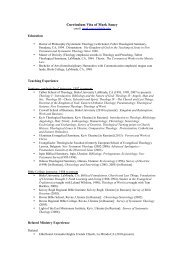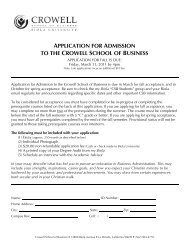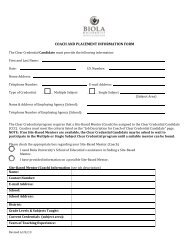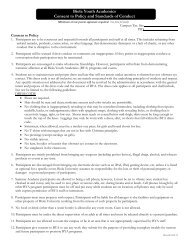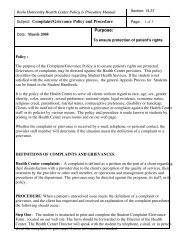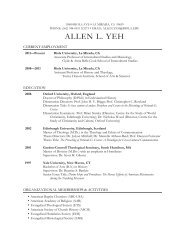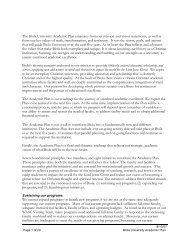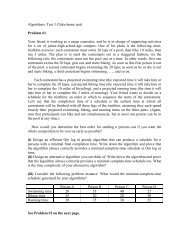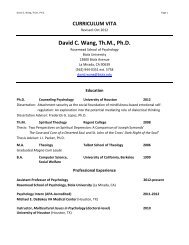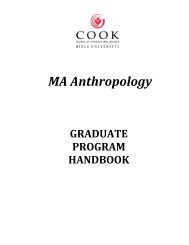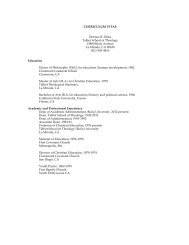WEAK VERB ROOTS IN HEBREW
WEAK VERB ROOTS IN HEBREW
WEAK VERB ROOTS IN HEBREW
Create successful ePaper yourself
Turn your PDF publications into a flip-book with our unique Google optimized e-Paper software.
<strong>WEAK</strong> <strong>VERB</strong> <strong>ROOTS</strong> <strong>IN</strong> <strong>HEBREW</strong><br />
All Hebrew verbs can be thought of spatially as containing three fields. The first field is<br />
reserved for PREFIXES (special prefixes, prefixes of the PC, and a stem augment, in that order).<br />
The second field is reserved for the BASE, which consists of the ROOT and any vowels. The<br />
third field contains any SUFFIXES (SC endings and verbal suffixes, in that order).<br />
SUFFIXES BASE PREFIXES<br />
W rm.v. yI<br />
1. When confronted with any form for which you want to determine the root, the first step is to<br />
eliminate any prefixes and suffixes from the base.<br />
A. Regarding PREFIXES, keep in mind the following:<br />
1. w at the beginning of a form is always the prefixed “and.”<br />
2. The special form of waw-consecutive always indicates a PREFIX CONJUGATION.<br />
Therefore, the form must have a, t, y, or n as a prefix.<br />
EXAMPLE: drm;v', “I<br />
watched you;” yNIr
B. If there are three letters in the base:<br />
1. These are generally the root:<br />
lDeb.Y:w: — base is lDeb., root is ldb<br />
WmWqy" — base is mWq, root is ~wq (see also “E” below)<br />
2. If in first position you have A or y (with no vowel under it), then the first root letter<br />
(R 1 ) is yod (y).<br />
dr
impression of a nifal triangle in forms of the qal with no ending: aF'YIw: (“and he<br />
lifted up” = qal).<br />
b. EXCEPTION 2: if the two letters are xq (in that order), then the root is xql.<br />
xQ;yI — the base is xQ;, the root is xql.<br />
2. If no strong dagesh is present in the first of the two letters, check the following<br />
possibilities:<br />
a. The third root letter is h:<br />
War" — the base is ar", the root is har.<br />
!b,YIw: — the base is !b,, the root is hnb.<br />
b. The middle root letter is w or y:<br />
Wmq' — the base is mq', the root is ~wq.<br />
hm'f' — the base is mf', the root is ~yf.<br />
c. The first root letter is y: dleTe — the base is dle, the root is dly.<br />
1) NOTE: The tsere with the prefix is a sign of this type of root.<br />
2) A special case: the apparent root *$ly is actually $lh.<br />
%l,YEw: — base is %l,, apparent root is *$ly, actual root is $lh.<br />
D. If there is only one letter in the base: The first root letter is n and the third is h.<br />
%Y:w: — the base is %, the root is hkn.<br />
2. SPECIAL CHARACTERISTICS OF CERTA<strong>IN</strong> <strong>WEAK</strong> <strong>ROOTS</strong><br />
A. Middle-vav/yod roots (w or y as the second root letter, “hollow verbs”):<br />
1. The PREFORMATIVE VOWEL for the qal AND hifil is qamets. If the characteristic<br />
vowel is “u” class, the form must be qal; if it is “i” class, it may be either qal from a<br />
root with y or (usually) hifil:<br />
~Wqy" – “he will stand up” (qal) ~yqiy" — “he will raise up” (hifil)<br />
~yfiy" — “he will place” (qal, but the root is ~yf).<br />
2. The piel and hitpael are usually replaced by forms called polel and hitpolel. Notice<br />
that the PREFORMATIVE VOWEL is still shewa.<br />
Wmm.Aqy> — “they will raise up” (polel from ~wq)<br />
hm'm.Aqt.mi — “one rising up against” (hitpolel from ~wq)<br />
B. Final-he roots (h as the third letter):<br />
1. The infinitive construct has the END<strong>IN</strong>G tA— .<br />
tAf[]l; — base is f[], root is hf[<br />
2. The 3m/fs PC has an “apocopated” (shortened) form for the jussive and for the wci.<br />
f[;y: (“let him make”; cf. hf,[]y:, “he will make”) — root is hf[<br />
!b,YIw: — root is hnb<br />
Weak Roots in Biblical Hebrew; page 3 (Dr. Finley)
3. Any h at the end of a word following the vowel tsere or segol must be a root letter:<br />
ha,r>a, — root har haer> — root har.<br />
4. The h is dropped before verbal suffixes: WNa,r>a, — “I see him.”<br />
C. Initial-yod roots (with y as R 1<br />
), TYPE 1:<br />
1. These verbs are not as common as type 2. Examples include arEy", be afraid; rc;y",<br />
form, fashion; bjy, be good.<br />
2. For these roots, the y becomes a vowel letter in certain forms:<br />
a. Qal PC: bj;yyI, bj;yTi, bj;yai, etc.<br />
b. Hifil SC: byjiyhe, hb'yjiyhe, T'b.j;yhe, etc.<br />
c. Hifil PC: byjiyyE , byjiyTe, byjiyae, etc.<br />
D. Initial-yod roots (with y as R 1<br />
), TYPE 2:<br />
1. Yod drops out only in the qal.<br />
W[D. (“know”) — since it is from [dy, it must be qal. Why?<br />
aceae (“I will go out”) — qal PC from acy.<br />
2. Yod is replaced by A in the hifil.<br />
dyliAh (“he begat”) — hifil from root dly.<br />
3. In the nifal, the yod is replaced by vav with strong dagesh in the PC, imperative, and<br />
infinitive construct; by A in the SC and participle:<br />
[d;W"yI — “it will be known” (nifal PC) dleW"hi — “being born” (nifal inf. constr.)<br />
dl;An — “he was born” (nifal SC) dl'An — “one being born” (nifal ptcp.)<br />
4. In the qal infinitive construct, the yod drops and a tav END<strong>IN</strong>G is added.<br />
td,r,l' (“to go down”) t[;d;l' (“to know”) tacel' (“to go out”) tb,v,l' (“to sit)<br />
E. Initial-nun roots (with n as R 1<br />
)<br />
1. Assimilation (shown by strong dagesh) occurs always in the following forms:<br />
a. Qal PC: aF'YIw: —base aF', root afn, qal wci (“and he lifted up”)<br />
b. Hifil — all forms:<br />
dyGIh'l] — base dGe, root dgn, hif. inf. constr. (“to tell”).<br />
dyGIy" — PC, 3ms; dyGIm; — ptcp. ms; dGEh; — imperative, 2ms<br />
2. In the qal of some roots the nun drops out for the imperative and infinitive construct.<br />
The inf. constr. has an added tav.<br />
WnT. — “Give!”; root !tn<br />
tv,g
3. Determining the Pattern<br />
A. Qal: this is the generic pattern. It is often recognized by what it is not (e.g., no augment,<br />
no prefixed mem or nun with the participle, etc.).<br />
1. Perfect, participle, imperative, and infinitives:<br />
a. No augment<br />
b. No signs of the piel<br />
2. Imperfect or Prefix Conjugation:<br />
B. Niphal<br />
a. Vowel with the prefix will be either:<br />
1) Chireq normally — rmov.yI<br />
2) Patach if first root letter is a guttural — rbo[]y:<br />
3) Qamets if from a “hollow” root — ~Wqy"<br />
4) Tsere if from an initial yod root — aceTe (root acy)<br />
5) Segol with alef or with a stative root —<br />
rmov.a, ; qz:x/y<<br />
6) Cholem with initial alef roots — rm,aOYw: (then he said)<br />
7) Sheva under special conditions — yhiy>w: (& he was); hn"ym,WqT. (they [f] will<br />
stand up)<br />
b. Characteristic vowel will be:<br />
1) Cholem normally: rbo[]y:<br />
2) Patach with a stative root or with a guttural in second or third position:<br />
dB;k.yI (he will be heavy); [r:q.yI (he will tear); [d;ae (I will know)<br />
3) Qamets with a final alef root: ar"q.yI (he will call)<br />
4) Segol with a final he root (true of all the patterns) or with some forms of<br />
initial alef: hf,[]y: (he will do); rm,aOYw: (then he said)<br />
1. Perfect and participle: augment nun (always): yTir>m;v.nI ; tr
C. Piel<br />
1. No augment = perfect and infinitives without any prefix (formative)<br />
2. All forms: strong dagesh in second root letter, unless it is guttural or resh or in some<br />
cases if it has a sheva with it:<br />
T'r>B;vi (you smashed); T'k.r:Be (you blessed); Wvq.Bi (they sought)<br />
3. Imperfect: will always have the vowel sheva with the prefix: rBed;y> (he will speak)<br />
4. Participle: will always have a mem prefix with a sheva: ~yLig:m. (root = hlg)<br />
D. Hiphil<br />
1. Perfect, imperative, and infinitives: must have an augment he:<br />
yTil.d;b.hi (I divided); dGEh; (Tell!; root dgn); dyGIh;l. (to tell)<br />
2. Imperfect, imperative, and infinitives: prefix vowel will be,<br />
a. Patach normally: lDeb.y: (let it divide); hBer>h; (multiplying [inf. abs.])<br />
b. Qamets with hollow roots: ~yqiy" (he will establish); Wbyvih' (Return [it]!)<br />
c. Cholem-vav with initial yod roots (applies also to perfect):<br />
yTib.v;Ah (I have settled [the people]); W[ydiAy (they will make known)<br />
E. Hitpael: Look for the —it— sound as augment: WvD.q;t.hi (they sanctified; Sanctify<br />
yourselves!)<br />
F. Participles in all patterns<br />
1. Qal = no prefix (rmevo = active participle; rWmv' = passive participle)<br />
2. Niphal = nun prefix (rm'v.nI)<br />
3. Piel = mem prefix + sheva (rBed;m.)<br />
4. Hiphil = mem prefix + patach (etc. as listed above for imperfect; lyDib.m;)<br />
5. Hitpael = mem prefix + -it sound (lLeP;t.mi)<br />
Weak Roots in Biblical Hebrew; page 6 (Dr. Finley)



